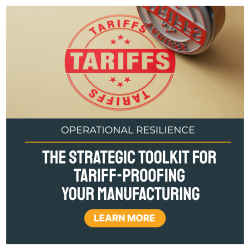These shifts in global trade policy might seem daunting, but here’s the good news: with the right preparation, challenges can become opportunities. Now is the ideal time to examine your operations and adopt or reinvigorate operational excellence, a powerful strategy to mitigate tariff impacts while keeping your business agile, resilient, and positioned for long-term success. By focusing on efficiency, cost management, and innovation, you’ll create a strong foundation that ensures your organization thrives—no matter what comes your way.
Should these tariffs take effect, manufacturing leaders should explore these seven Operational Excellence best practices to stay aligned with your annual goals. Implementing even a few can greatly strengthen your business’s resilience, helping to offset revenue losses from tariffs and maintain strong financial performance.
1. Build Financial Resilience
Take control of your cost to produce in order to mitigate the impacts of tariffs. Improve cost visibility and accountability so your team can allocate resources more effectively, sustain profitability, and build resilience against external market pressures.
2. Flex Your Supply Chain Strategy
Your supply chain plays a key role in reducing tariff vulnerabilities by becoming more flexible in sourcing, procurement or possible relocation. Review and refine your supply chain strategies to effectively respond to evolving trade conditions and minimize risks. These actions address immediate tariff challenges while establishing a strong foundation for operational agility.
3. Identify New Opportunities for Peak Operational Performance
Operational efficiency lays the groundwork for countering rising costs and maintaining profitability. Proactively implement strategies that streamline workflows, reduce waste, and unlock untapped potential within their operations to tackle financial pressures head-on.
4. Leverage Advanced Technology
Manufacturing technologies offer a powerful way to boost agility, productivity and enhance decision-making in an increasingly complex market. Beyond solving immediate issues, these technologies empower businesses to uncover and act on long-term improvement opportunities.
5. Rethink Product Design
Simplifying and optimizing products is key to reducing costs and improving margins, especially in the face of rising material expenses. The following strategies will guide teams in evaluating product line profitability and uncovering opportunities to streamline operations, boost efficiency, and enhance customer value.
6. Build a Cost-Conscious Culture
Creating a culture focused on efficiency and cost reduction amplifies the impact of operational improvement. Engage employees at every level to drive cost-saving initiatives and align their efforts with broader business goals. This unified approach not only strengthens accountability but also fosters continuous improvement across the organization.
7. Maintain Momentum with Metrics
Define and track clear metrics to sustain improvement and ensure accountability at the point of impact. Metrics provide a roadmap for evaluating progress, identifying gaps, and aligning your team’s efforts with overarching business goals. Build a robust measurement framework that drives continuous success and keeps your organization focused on impactful results.
A Balanced Strategy for Thriving Amid Tariffs
Navigating tariff challenges requires strategic foresight and adaptability. By embracing these practices, you’re not just protecting your business against tariffs; you’re building a more efficient, competitive enterprise. The journey to operational excellence is ongoing, but with the right approach, manufacturers can turn challenges into opportunities for growth and innovation.






